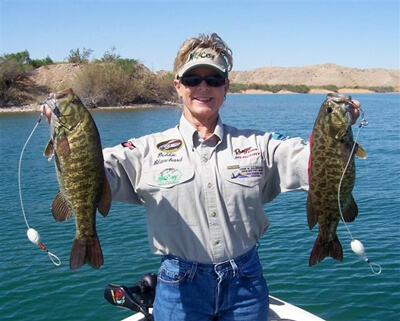 Photo
Credit Margie Anderson Arizona Bureau Chief Photo
Credit Margie Anderson Arizona Bureau Chief
Havasu is a dynamite place to take the family, even if they donít like to fish. Lake Havasu City is right on the shore with lots of great hotels and restaurants, so you can spend time on the water while the family plays on shore.
RV Parks, Campgrounds
There are RV parks and campgrounds all around the lake, too. There are good public launch areas scattered along the length of the 45-mile-long lake, and wildlife preserves at each end of the lake offer some outstanding wildlife viewing. If gambling is one of your vices, Laughlin, Nev., is only a short distance up the road from Lake Havasu City.
The clear waters of Lake Havasu give the lake its name ó Havasu is an Indian word that means "blue." The clear water can make fishing tough though, especially for newcomers.
Both of the river ends of Havasu, the Bill Williams River in the south, and the Colorado River in the north, have an abundance of thick tules that stretch for what looks like miles. These tules are so thick that bass inside them are virtually inaccessible.
And, although the level of the lake fluctuates only about 5 feet over the year, this change can be enough to keep boaters from getting through the tules into the backwaters where the big fish are.
In the early part of the year, the low water level forces the fish to come out of the tules, so fishing improves in the Bill Williams River. Flipping black and blue or pumpkin jigs along the edges of the tules is a good way to catch these bass, and some anglers fish crankbaits parallel to the weed lines.
Anglerís Advice
We visited Havasu with Dean Farrell, an Arizona tournament angler. "When you find a fish on Havasu, it's almost guaranteed to eat," says Farrell. He likes to fish the north end of the lake in the Colorado River. "If the river bite is going," he declares, "that's where tournaments are won."
The fish that live in the river are bigger and stronger from dealing with the current all the time, he explains. The river is good fishing off and on all year, and especially good when the water is up.
When we were at Havasu with Farrell, we started fishing rocky banks in the Colorado, throwing crankbaits and spinnerbaits along the shore and following up with jigs and worms. "Good colors here are anything with red on it, along with white and pink for plugs and spinnerbaits," Farrell says, and he prefers darker colors for worms and jigs.
Farrell keeps a 6-inch purple and red worm tied on at all times, on light line. When a bass comes out of the tules and hits his jig or spinnerbait without taking it, he tosses in the little worm.
In Sight
At Havasu, almost all the fishing is sight fishing. You can see the bass down in the water, and the trick is to get them to take a lure without scaring them away.
The whole lake has good weedbeds until the cold weather causes them to die off. Early in the year, the weeds start to grow, and they sometimes get so thick that they block access to the backwaters by late summer.
These weedbeds are good places to throw a crankbait ó especially in warmer weather. Topwater lures fished over the weeds in summer are dynamite.
One of the most popular topwater lures at Havasu is the Sammy, a topwater lure. This bait is fished with a "walk-the-dog" motion over weedbeds with explosive results.
In the spring, the backs of coves and the pockets in the rivers provide some of the best fishing. Sight fishing with Gitzits, and throwing buzzbaits or topwater plugs over weeds are two of the best producers. Jerkbaits on secondary points produce well, too, and so do Rat-L-Traps, spinnerbaits, and shad-colored Slug-Gos.
Flipping or pitching to the tules is good almost all year long, and the trick is to find the most productive spots. The tules stretch out along the shore forever, and one way to find the places that hold fish is to throw a spinnerbait or crankbait along the edges and watch for fish to come out. If you see a fish, or get bit and miss it, stick around and fish the tules very thoroughly with a worm or a jig.
Summer Stripers
Summer is the height of tourist season, and weekends can get crowded. Weekdays during the summer are not as crowded, and anglers can boat some bass by getting on the water early to throw jigs and topwater lures along steep rock banks.
Deeper grassbeds will also hold fish in summer, and jigs, deep-diving crankbaits, and split-shotting are a few of the techniques that will get them to bite.
Summer is also the height of the striper season, and each year, there is a huge striper tournament at Havasu that draws thousands of people. Bass anglers can expect to catch quite a few stripers on their quest for largemouth bass, and the stripers will give you quite a ride for your money.
Fall starts around October at Havasu, and Farrell's number one choice of lure for fall is a buzzbait. He'll throw a buzzbait all day long in the fall, along with rip baits, topwater plugs, and flipping in the Colorado.
A lot depends on the level of the water. If the water is high, he'll head for the river every time. If not, he'll stick to the main lake area.
The backwater areas in the Colorado are some of his favorite spots, and in fall, they can be difficult to reach. Narrow trails through the tules lead to beautiful pools that are invisible from the river channel, and these quieter pockets sometimes hold the biggest fish on the lake. When the water is down, reaching these pools is either very difficult or impossible.
Sight fishing with tubes is a fantastic way to catch bass in the backwaters. Stay back and pitch a tube bait to the fish. Rig them as lightly as possible ó 3/16-ounce or even 1/8-ounce sinkers are fine.
Words From Havasu Expert
Best colors are brown with black flakes, pumpkinseed, and camo green because they look like the crawfish and baitfish in the lake. (This info is straight from Barry Hill, a legendary Havasu angler.)
Hill once told me that you can fish shallow all year at Havasu. He said that if you leave 10 feet of water, you miss a lot of fish because Havasu is basically a river, and the fish just donít go deep. Occasionally, you can work a jig or a deep-diving crankbait past the 10-foot mark, but not very often, and usually only in the coldest or the hottest part of the year.
From the end of March until late October, fish the grass beds in the main lake. Split-shotting, Texas-rigged worms, and Pop-Rs are excellent techniques for probing the grass beds. Senkos fished over grass beds will also produce a lot of bass.
The best way to get a limit of fish on Havasu is to have a milk run. Get about 10 spots that you feel hold fish, and just keep going back to them over and over all day. There are a lot of fish in Havasu, including bass, crappie, and stripers.
An Excellent Family Vacation
The habitat improvement program at Havasu is making a good lake even better, and with all the amenities available, Lake Havasu is one of the best places in the West to take a family vacation. In this tourist-oriented area, the people are very friendly and eager to please, so load up the tackle and the kids and get yourself to Lake Havasu for the time of your life.
|
If you would like advertising information on either the web site or the print version please contact advertising@azbw.com


















































